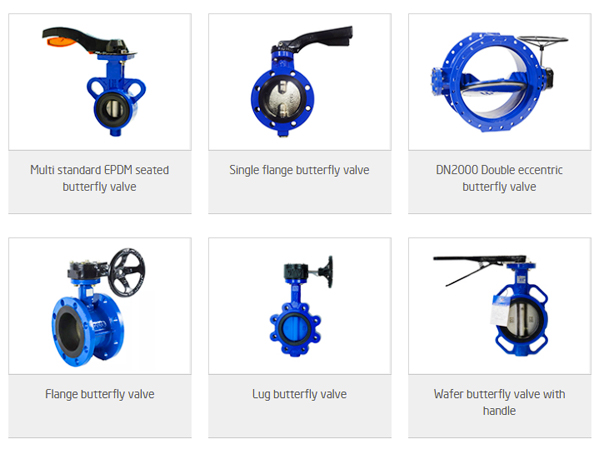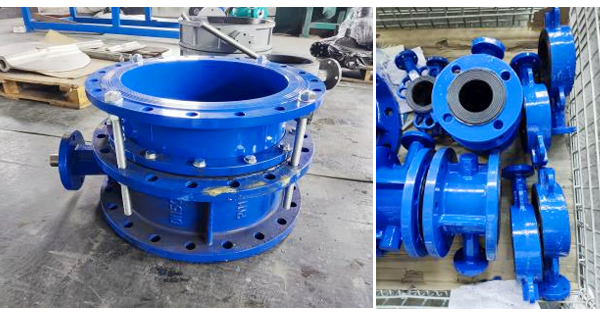- Gate valve
-
- DN1000 Extension stem double flange soft seal gate valveDIN F4 resilient seated gate valveDN450-1200 Resilient Seated Gate ValveDIN F5 resilient seated gate valveSocket connection soft seal gate valveUnderground cap soft seal gate valveBS5163 rising stem soft seal gate valveHard seal gate valveAPI slab Gate ValveStainless steel flange gate valveWafer knife gate valvePneumatic gate valveSoft seal gate valveExtension stem gate valveUL/FM fire protection groove ends gate valveRising stem forged steel gate valvecarbon steel gate valveStainless steel threaded gate valveDIN soft seal gate valveANSI soft sealing gate valve 200PSICast iron gate valveBS resilient seated gate valve
- Butterfly valve
-
- DN900 pneumatic triple eccentric hard seal butterfly valveD643H Triple Eccentric Butterfly ValveD343H Hard seal butterfly valveMulti standard EPDM seated butterfly valveSingle flange butterfly valveDN2000 Double eccentric butterfly valveFlange butterfly valveLug butterfly valveWafer butterfly valve with handleWorm gear operated butterfly valveWafer lined fluorine butterfly valveStainless steel wafer butterfly valveStainless steel flanged butterfly valveThree eccentric flange butterfly valvePneumatic flanged butterfly valvePneumatic wafer butterfly valveTriple eccentric butterfly valve wafer typeWafer butterfly valve ULC approvedInflatable seat butterfly valveHigh performance butterfly valveGrooved end butterfly valveElectric soft seal butterfly valveFlange fluorine lined butterfly valveHandle aluminum butterfly valveWorm Gear Aluminum Butterfly ValveFull PTFE lined butterfly valve wafer typeOne stem no-pin wafer butterfly valveMulti standard aluminum stem butterfly valveStainless Steel wafer Butterfly ValveAluminium handle operated lug butterfly valveLever Operated Flange Butterfly ValveButterfly valve stemButterfly valve discButterfly valve seat
- Ball valve
-
- DN1400 top-mounted eccentric semi-ball valveFlanged three-way ball valveFully welded ball valveNatural gas ball valveHigh platform flange ball valve1 PC ball valveFixed ball valvePTFE seat flanged ball valveMetal seat ball valveAPI 6D ball valve3 Piece ball valveFull Bore 3 way ball valve L-Port3 Way T-Port ball valve2PC Ball valve female thread stainless steel
- Globe Valve
-
- API Carbon Steel Globe ValveBellows Globe ValveStainless steel flange globe valveStainless steel thread S type globe valveStainless steel thread B type globe valveCast Steel Globe ValvePiston Globe ValveWCB Carbon Steel Globe Check Valveelectric motorized control stainless steel SS316 globe valveBrass Globe ValveCryogenic Globe valveHT200 Globe ValveThreaded Stainless Steel Globe ValveGG25 Globe ValveANSI API Cast Steel And Stainless Steel Globe valve
- Check valve
-
- Rubber seal check valveDN800 Slow closing check valveDN800 Rubber Disc Check ValveButterfly Buffering Check Valvecheck valve with counter weightSilent Check ValveWCB Swing check valveSwing Check ValveSingle Chip Check Valve H74WStainless Steel Wafer Check ValveSwing Start Check ValveFoot check valveAPI Swing Check ValveDIN Flange check valveSingle plate check valveLifting Check ValveBottom ValveHammer Diminish Noises Check ValveWafer Check ValveWafer dual plate check valve
- Control valve
-
- Static Balancing ValveCage Guided Sleeve Globe Control ValveDN1000 Piston Flow Regulating ValveDN1600 Electric Actuator Flow Regulating ValvePneumatic Flanged Butterfly ValvePneumatic Wafer Butterfly ValveAngle Seat ValvePneumatic gate valveElectric three-way control valveElectric sleeve control valve
- Water Meter
-
- Vertical Type Water MetersStainless steel threaded water meterPiston water meterPlastic water meterMore flow rotor dry water meterspiral vane flange water meterCI wotlman water meter with pulse outputLXCLG(R) Vertical removable element woltman cold (hot) water meterSingle flow rotor dry water meterPrepaid Token Water MeterElectromagnetic flowmeterRotary Piston Liquid Sealed Water MeterRotary Piston Liquid Sealed Water Meter
- Air valve
-
- Double ball exhaust valveDoubleair Air Valve SaudiDoubleair Air Valve Southeast AsiaDoubleair Air Valve South AmericaDouble Air ValveThreaded Air ValveSingle Air ValveTriple Functions Air ValveAutomatic Air Release ValveAutomatic release valveAutomatic exhaust valveComposite Exhaust Air ValveBrass exhaust valveDouble Ball Air Valve
- Pipe Repair & Coupling
-
- Flexible Multi-Function Pipe Coupling ZFJ-SSS Semi-Circle Pipe Repair Clamp SJW-HDuctile Iron Band Repair ClampStainless Steel Band Repair ClampDouble-Section Pipe Repair CouplingFolding Type Pipe RepairSingle-Section Multi-Function Pipe Coupling MF-SGear-Ring Type Multi-Function Pipe Coupling GR-SZBW Damping Corrugated Hose
- Dismantling Joint
-
- VSSJAFC(CC2F) Detachable Flange Transmission JointVSSJA-2(B2F) Double Flange Limited Expansion JointVSSJA-1(BF) Single Flange Limited Expansion JointVSSJA(AF) Flange Loose Expansion JointJGD-B Threaded Rubber JointZBW Damping Corrugated HoseKXT-S Flexible Dual-Spherical Rubber JointKXT Rubber Soft JointFlange Adaptor
Why are they called butterfly valves?
1. Definition of butterfly valve:
Butterfly valve is a rotary valve with a disc-shaped closing member (can be round or rectangular, etc.) rotating 90° or about 90° to open and close the valve. Butterfly valve is an ancient valve, early due to poor sealing performance, can only be used for adjustment, such as the flue valve is a kind of adjustment butterfly valve. With the emergence of synthetic rubber and other resilient sealing materials, as well as the in-depth study of the sealing mechanism, there is a sealed butterfly valve. The emergence of resilient metal seats and new structural forms, so that the butterfly valve in high temperature, low temperature environment is also gradually adopted. The current development trend of butterfly valve is that it can be used for both regulation and sealing.
2. Classification of butterfly valve:
Butterfly valve can be classified by various methods, for example, butterfly valve can be divided into cut-off type and regulating type according to the use and role; divided into midline, single eccentric, double eccentric and triple eccentric butterfly valve according to the structure form; divided into rubber sealed butterfly valve, teflon sealed butterfly valve and metal sealed butterfly valve according to the sealing material.
3. Butterfly valves have several key features that make them popular in various industries and applications.
Some of the main features of butterfly valves include:
Compact and lightweight design:
Butterfly valves have a compact and lightweight construction, making them easy to install and suitable for applications where space is limited.
Quick and easy operation:
Butterfly valves provide quick and efficient operation with their quarter-turn mechanism. They can be opened or closed rapidly, minimizing the time required for flow control.
Cost-effective:
Butterfly valves are generally more cost-effective compared to other types of valves, such as gate valves or globe valves. Their simple design and fewer components result in lower manufacturing, installation, and maintenance costs.
Low pressure drop:
Butterfly valves offer low pressure drop across the valve, meaning they cause minimal resistance to flow when fully open. This can contribute to energy savings and reduced pumping costs.
Versatility:
Butterfly valves can handle a wide range of fluids, including gases, liquids, and slurries. They are available in various materials of construction, such as metal or resilient liners, to suit different media and operating conditions.
Excellent flow control:
Butterfly valves provide good flow control capabilities, allowing for precise regulation of flow rates. They can be used for both on-off and throttling applications, providing flexibility in system operation.
Tight sealing:
Butterfly valves typically have a tight sealing capability when closed, preventing leakage and ensuring system integrity. This is achieved through various sealing mechanisms, such as elastomeric or metal seals.
Low friction and torque requirements:
Butterfly valves have low frictional resistance, resulting in low torque requirements for operation. This makes them suitable for manual operation or actuation with smaller and more cost-effective actuators.
Resilient to high velocities and pressures:
Butterfly valves can withstand high flow velocities and pressures, making them suitable for demanding applications in industries like water treatment, HVAC, and oil and gas.
Ease of maintenance:
Butterfly valves are relatively easy to maintain due to their simple design and fewer components. They can be quickly disassembled, inspected, and repaired or replaced if necessary.
4. Butterfly valves are widely used in various industries and applications for flow control.
Some of the common applications of butterfly valves include:
Water and wastewater treatment:
Butterfly valves are extensively used in water treatment plants, wastewater treatment plants, and distribution systems to control the flow of water, chemicals, and slurry.
HVAC systems:
Butterfly valves are commonly employed in heating, ventilation, and air conditioning (HVAC) systems to regulate the flow of air and water in ductwork, cooling towers, and chiller units.
Oil and gas industry:
Butterfly valves find application in the oil and gas industry for controlling the flow of crude oil, natural gas, and various fluids in pipelines, refineries, and storage terminals.
Chemical processing:
Butterfly valves are used in chemical plants to regulate the flow of chemicals, acids, solvents, and other corrosive fluids in pipelines and reactors.
Power generation:
Butterfly valves are utilized in power plants, including thermal power plants and renewable energy facilities, to control the flow of steam, cooling water, and other fluids in boilers, turbines, and cooling systems.
Marine and shipbuilding:
Butterfly valves are commonly used in marine and shipbuilding applications to control the flow of water, fuel, and other fluids in piping systems, ballast tanks, and marine propulsion systems.
Pharmaceutical and biotech industries:
Butterfly valves are employed in pharmaceutical and biotech industries for controlling the flow of liquids and gases in processing equipment, reactors, and cleanroom environments.
Food and beverage industry:
Butterfly valves find application in the food and beverage industry for controlling the flow of liquids, such as milk, juices, beer, and wine, in processing and packaging systems.
Mining and mineral processing:
Butterfly valves are used in mining operations and mineral processing plants to regulate the flow of ore slurry, tailings, and other mineral-based fluids in pipelines and separation equipment.
Fire protection systems:
Butterfly valves are utilized in fire protection systems to control the flow of water or fire suppressant agents in sprinkler systems and fire hydrants.
Each of our products has undergone strict inspection and testing before reaching your hands.
We look forward to working with you again!
To learn more about our products, please contact:
WhatsApp: +86 13849184495
Email: weisidun888@gmail.com









